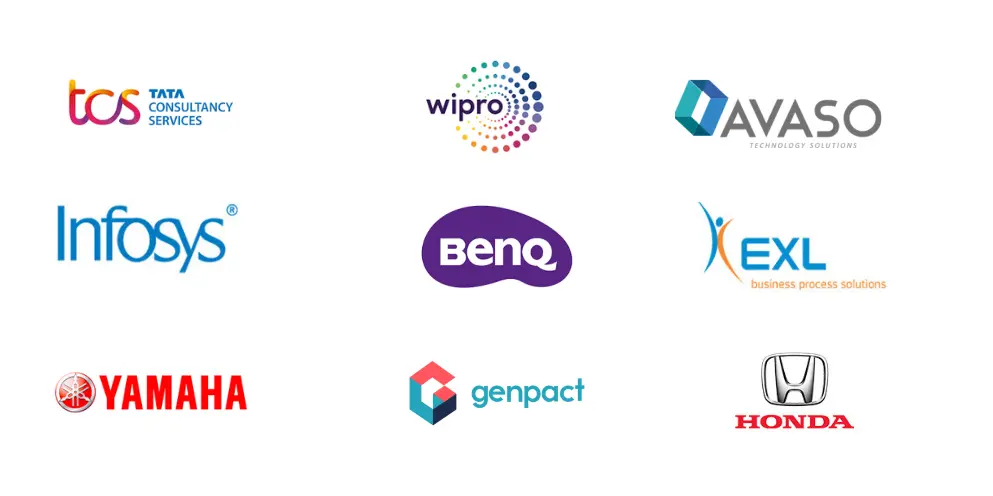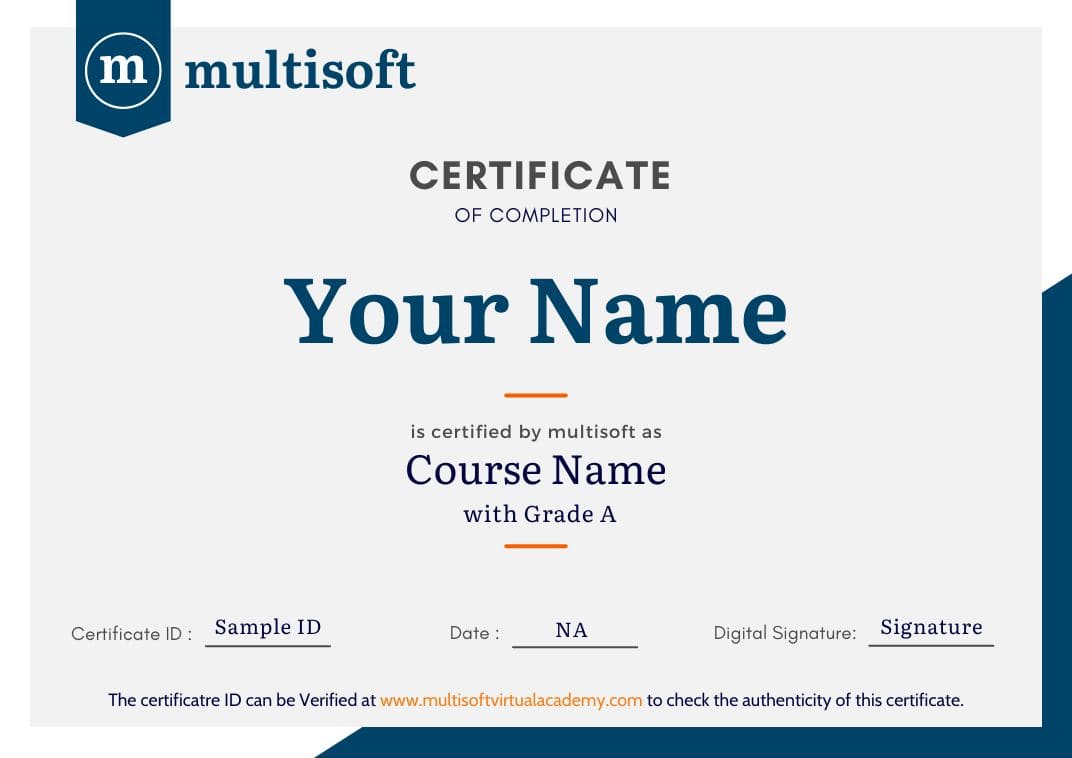Trusted by enterprises across the globe


Designed for all your training needs

Flexible On-Demand Group Learning
Flexible, corporate learning for groups, accessible anytime, anywhere.

Instructor-Led Live, Online Training
Real-time, interactive classes taught by SME via web conferencing.

Independent Self-Paced Learning
Individual learning at your own speed, with access to digital materials.

Customized On-Site Training
Customized, face-to-face training sessions delivered at your location.
Curriculum Designed by Experts
To pursue this course, you are supposed to have a minimum work experience of five years in IT, including one year of cloud security experience and three years of information security. This online course will help you in knowing the process of planning for disaster recovery and business continuity, understand the design principles of secure cloud computing, and knowing the process planning for disaster recovery and business continuity.
Topics
- Domain and Learning Objectives
- Security Concepts
- Key Security Concepts, Defense in Depth, Due Care, and Due Diligence
- Security Controls and Functionalities
- Cloud Computing Concepts
- Business Drivers
- Scalability, Elasticity, Vendor Lock-in, and Vendor Lock-out
- Cloud Computing Concepts: Advantages
- Cloud Reference Architecture
- Cloud Computing Roles and Actors
- Cloud Service Categories: Infrastructure as a Service (IaaS)
- Cloud Service Categories: Platform as a Service (PaaS)
- Cloud Service Categories: Software as a Service (SaaS)
- Cloud Service Categories: Management
- Cloud Deployment Models: Public Cloud
- Cloud Deployment Models: Private Cloud
- Cloud Deployment Models: Hybrid Cloud
- Cloud Deployment Models: Community Cloud
- Models and Characteristics
- Comparison of Cloud Deployment Models
- Case Study: Hybrid Cloud
- Cloud Technology Roadmap
- Impact of Related Technologies
- Cryptography, Key Management, and Other Security Concepts
- Key Management
- IAM and Access Control
- Data Remanence
- Virtualization
- Cloud Computing Threats
- Design Principles of Secure Cloud Computing
- Cost-Benefit Analysis
- Evaluate Cloud Service Providers
- SOC
- IT Security Evaluation
- FIPS
- Scenario
- Key Takeaways
Topics
- Domain and Learning Objectives
- Cloud Data Life Cycle
- Cloud Data Life Cycle: Create, Store, Use, and Share
- Real-World Scenario
- Cloud Data Life Cycle: Archive
- Cloud Data Life Cycle: Destroy, Key Data Functions
- Cloud Data Storage Architectures
- Cloud Data Storage Architectures: Storage Types for IaaS
- Cloud Data Storage Architectures: Storage Types for PaaS
- Cloud Data Storage Architectures: Storage Types for SaaS
- Cloud Data Storage Architectures: Threats to Storage Types
- Real-World Scenario
- Data Security Strategies
- Data Security Strategies: Encryption (Use Cases)
- Data Security Strategies: Encryption Challenges
- Data Security Strategies: Encryption in IaaS
- Data Security Strategies: Database Encryption
- Data Security Strategies: Key Management
- Data Security Strategies: Key Storage in the Cloud
- Data Security Strategies: Masking
- Data Security Strategies: Data Anonymization
- Data Security Strategies: Tokenization
- Data Security Strategies: Homomorphic Encryption and Bit Splitting
- Real-World Scenario
- Data Security Strategies: Data Loss Prevention
- Scenario
- Data Discovery and Classification Technology
- Data Discovery and Classification Technology: Data Classification
- Data Discovery and Classification Technology: Challenges with Cloud Data
- Jurisdictional Data Protections for Personally Identifiable Information (PII)
- Privacy Acts: GDPR
- Privacy Acts: Data Protection policies
- Privacy Acts: United States
- Privacy Acts: HIPAA, FISMA, and SOX
- Jurisdictional Data Protections for PII: Responsibilities of Cloud Services
- Data Rights Management
- Data Retention, Deletion, and Archiving Policies
- Data Retention
- Data Deletion
- Real-World Scenario
- Data Archiving
- Real-World Scenario
- Legal Hold
- Auditability, Traceability, and Accountability of Data Events
- SIEM
- Chain of Custody
- Nonrepudiation
- Real-World Scenario
- Key Takeaways
- Domain and Learning objectives
- Cloud Infrastructure Components
- Network and Communications
- Management Plane and Virtualization
- Factors That Impact Datacenter Design
- Physical Design: Buy or Build
- Physical Design: Data Center Design Standards
- Physical Design: Uptime Institute
- Physical Design: Tiers
- Physical Design: Features of Tiers
- Real-World Scenario
- Environmental Design Considerations
- Connectivity
- Hypervisor and Resource Allocation
- Risks Associated with Cloud Infrastructure
- Policy, General, and Virtualization Risks
- Cloud-Specific, Legal, and Non-Cloud Specific Risks
- Cloud Attack Vectors and Compensating Controls
- Business Scenario
- Design and Plan Security Controls
- Real-World Scenario
- Plan Disaster Recovery and Business Continuity
- DReal-World Scenario
- RBCDR Planning Factors and Disruptive Events
- Characteristics of Cloud Infrastructure
- BCDR Strategies and Returning to Normal
- Real-World Scenario
- BCDR Creation
- BCDR Creation: Test
- Business Requirements
- BCDR Creation: Report and Revise
- Testing Types, Uptime, Availability, Activity, and Case Study
- Security Training and Awareness
- Real-World Scenario
- Key Takeaways
- Domain and Learning objectives
- Advocate Training and Awareness for Application Security
- Real-World Scenario
- Common Pitfalls
- Encryption Dependency Awareness
- Business Scenario
- Understanding Software Development Lifecycle Process
- Real-World Scenario
- Vulnerabilities and Risks
- Threat Modeling
- Real-World Scenario
- Encryption
- Sandboxing and Application Virtualization
- Federated Identity Management
- SAML Authentication
- Identity and Access Management
- Multi-Factor Authentication
- Real-World Scenario
- Cloud Access Security Broker
- Application Security Testing
- Software Supply Chain Management
- Real-World Scenario
- Key Takeaways
- Domain and Learning objectives
- Secure Configuration of Hardware: Servers
- Secure Configuration of Hardware: Storage Controllers (Part 1)
- Real-World Scenario
- Secure Configuration of Hardware: Storage Controllers (Part 2)
- Secure Configuration of Hardware: Virtual Switches
- Configuration of VM Tools
- Configuration of VM Tools: Running a Physical Infrastructure (Part 1)
- Configuration of VM Tools: Running a Physical Infrastructure (Part 2)
- Configuration of VM Tools: Running a Physical Infrastructure (Part 3)
- Configuration of VM Tools: Running a Physical Infrastructure (Part 4)
- Real-World Scenario
- Securing Network Configuration (Part 1)
- Real-World Scenario
- Clustered Hosts
- Dynamic Optimization and Clustered Storage
- Maintenance Mode and Patch Management
- Performance Monitoring
- Real-World Scenario
- Network Security Controls: Layered Security and Honeypots
- Network Security Controls: SIEM
- Log Management
- Orchestration
- Availability of Guest OS
- Operations Management (Part 1)
- Real-World Scenario
- Operations Management (Part 2)
- Risk-Management Process: Framing Risk and Risk Assessment
- Quantitative Risk Analysis
- Scenario
- Risk Response and Risk Monitoring
- Collection and Preservation of Digital Evidence
- Communication with Relevant Parties
- Real-World Scenario
- Security Operations Center
- Key Takeaways
- Domain and Learning objectives
- Case Study
- Legislative Concepts
- Intellectual Property Laws
- Case Study
- Scenario
- Acts and Agreements
- Case Study
- NERC
- Privacy Shield and Generally Accepted Privacy Principles (GAPP)
- Jurisdictional Difference in Data Privacy
- Terminologies and eDiscovery
- Forensic Requirements and PII
- Gap Analysis, SOC Reports, and Chain of Custody
- Vendor Management
- Cloud Computing Policies and Risk Attitude
- SLA
- Quality of Service
- Risk Mitigation
- Risk Management Metrics and ISO 28000:2007
- Real-World Scenario
- Key Takeaways
Free Career Counselling
We are happy to help you 24/7Multisoft Corporate Training Features
Outcome centric learning solutions to meet changing skill-demand of your organizationWide variety of trainings to suit business skill demands
360° learning solution with lifetime access to e-learning materials
Choose topics, schedule and even a subject matter expert
Skilled professionals with relevant industry experience
Customized trainings to understand specific project requirements
Check performance progress and identify areas for development
Free Certified Cloud Security Professional (CCSP) Corporate Training Assessment
Right from the beginning of learning journey to the end and beyond, we offer continuous assessment feature to evaluate progress and performance of the workforce.
Try it Now

Certified Cloud Security Professional (CCSP) Corporate Training Certification
Related Courses
A Role Based Approach To Digital Skilling
A roadmap for readying key roles in your organization for business in the digital age.
 Download Whitepaper
Download Whitepaper












 Join our Live Instructor-Led online classes delivered by industry experts
Join our Live Instructor-Led online classes delivered by industry experts